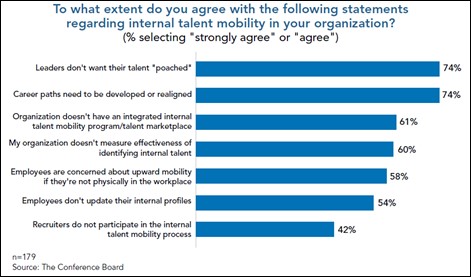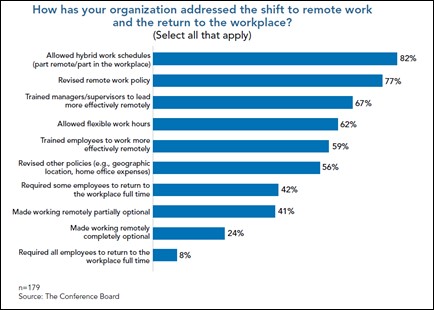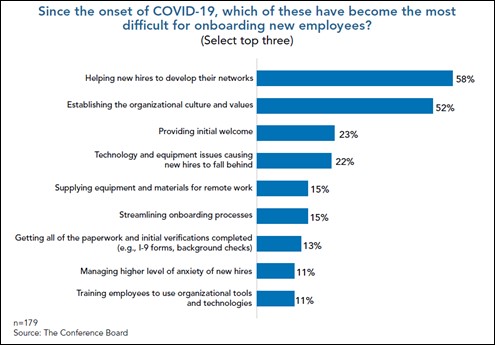6 essential keys to recruiting and retaining exceptional workers right now
A new report shows concrete steps companies can take to survive ‘The Great Resignation’ and stay afloat in a turbulent post-pandemic job market.

If you’re not concerned about finding and keeping enough top-level staffers to keep your corporate engine chugging through murky waters, you’ve not been paying close enough attention.
A new report from The Conference Board offers six tangible tips to recruit, engage and retain the employees you’ll need to thrive in a rapidly shifting corporate landscape.
The study culls and collates findings from online surveys of more than 175 talent acquisition (TA) and HR leaders and more than 2,400 workers, as well as conversations with TA and HR leaders, CHROs and CEOs.
The Conference Board’s takeaways include:
1. Broaden the talent pool by hiring workers with alternative credentials.
Many organizations have beefed up efforts to push diversity, equity and inclusion initiatives since last summer. The data shows:
- Alternative credentials open the door for organizations to consider a wider, more diverse range of candidates and for employees to consider roles that were previously unavailable to them.
- Eighty-one percent of TA and HR leaders agree that their focus on recruiting and hiring diverse candidates has intensified since the onset of COVID-19.
- Forty-eight percent of respondents say that going forward, there will be less reliance on four-year degrees and more reliance on alternative credentials.
- To capture this trend, The Conference Board recommends:
- Identify required skills, capabilities and credentials to meet current and future workforce needs.
- Alter the selection criteria of applicant tracking systems to include more granular skill identification and not erroneously eliminate candidates. (Read more on this topic here.)
- Create a culture that accepts alternative credentials.
2. Don’t hoard talent: Encourage internal mobility.
According to The Conference Board, talent mobility has taken on fresh importance in response to the hiring freezes many organizations faced early in the pandemic—and now even more so as they face talent shortages.
- Talent mobility is a vital way to influence workers to stay at an organization.
- However, 74% of organizational leaders don’t want their talent poached internally.
- Sixty-one percent of responding organizations do not have a cross-functionally integrated talent mobility program.
- Just 34% of surveyed TA and HR leaders report that their organizations have implemented an “internal talent marketplace” platform to enable employees to see all open positions and potential career paths.
- Fifty-eight percent of surveyed TA and HR leaders report that employees are concerned about upward mobility if they are not physically in the workplace.
- To overcome these obstacles, The Conference Board suggests:
- Reward leaders for facilitating the free movement of their employees.
- Develop a cross-functional integrated talent mobility program.
- Implement an internal talent marketplace.
- Give virtual employees the appropriate exposure to ensure they’re aware of internal options.

3. Be flexible about flexibility.
Workers have come to rely on the freedom and flexibility of remote work. Companies unwilling to compromise on this matter can expect high turnover moving forward.
- Most surveyed organizations are addressing the shift to remote work and the return to the workplace by:
- Allowing hybrid work schedules: 82%
- Revising their remote work policies: 77%
- The data suggests you might:
- Consider whether worker preferences meet organizational goals.
- Organizational policies regarding scheduling and remote work may need to vary across business lines and types of employees.

Robin Erickson, Ph.D., principal researcher of human capital at The Conference Board, had this to say about the findings:
“After more than a year and half of a relentless crisis that has upended conventional work arrangements for millions, workers are understandably demanding flexibility in where and when they work. Accommodating these preferences—where possible—is made all the more urgent by the recruiting and retention challenges posed by today’s competitive labor market.”
4. Optimize the candidate experience by prioritizing transparency and communication.
The surest way to delight your customers is to ensure your staffers feel secure, happy, motivated and respected. This starts with creating a seamless recruiting and onboarding experience.
Unfortunately, most companies are lacking in this regard. In fact, 79% percent of TA and HR leaders responding to this survey said they “must change the focus of the candidate experience.”
- To do so, you should:
- Communicate with candidates frequently and transparently.
- Assess the satisfaction of both hired and non-hired applicants with your hiring process.
- Ensure that your organization’s employment brand value proposition resonates with candidates’ and employees’ needs.
5. Transform the onboarding process for new employees.
COVID-19 has completely upended the onboarding process—especially for those who are entirely remote.
- Virtual onboarding has made the experience of becoming a new hire more difficult.
- Seventy-one percent of surveyed workers who had taken a new job since March 2020 say they were onboarded completely virtually.
- Just 59% of those surveyed workers who had been hired into different organizations found their onboarding helpful.
- Fifty-eight percent of TA and HR leaders say the most difficult part of onboarding new employees is helping them to develop their networks.
- Fifty-two percent of TA and HR leaders said establishing the organizational culture and values was the most difficult.
- To overcome these challenges, The Conference Board suggests:
- Ensure that new hires understand and experience the organizational culture by including sessions on purpose and values in new hire orientations.
- Hold hiring managers accountable for onboarding and ensure that they check in regularly with their new employees.
- Monitor your new hire retention numbers as they indicate whether your onboarding is adequate.

6. Invest in hiring managers through training and evaluation.
Hiring managers play a crucial role in employee experience, and organizations should hold them accountable for new hire retention. The data reveals:
- To better retain new hires, train and evaluate hiring managers.
- Just 46% of organizations have provided additional training for hiring managers since the onset of the pandemic.
- Fifty-five percent of surveyed respondents say their hiring managers do not know how to interview for soft skills.
- Fifty-six percent say that hiring managers require more “handholding” from recruiters now than before COVID-19.
- Take these steps to help them succeed:
- Educate hiring managers about the value of alternative credentials to the development of a more diverse workforce.
- Provide training for hiring managers on virtual interviewing, managing a remote workforce, behavioral interviewing, effective communication and relationship management.
- Recognize the risk to the success of the organization if training is not provided to hiring managers and evaluate their performance.
Over to you, readers. Is your company rethinking recruiting and retention during this time of upheaval, or are you still going with the status quo? Regardless of how you plan to proceed, it’s well worth consideration as this red-hot labor market shows no signs of cooling off anytime soon.


